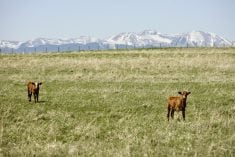Calving season is the time when most calves die. Surveys show that mortality in beef herds from birth to weaning ranges from three to seven per cent. A realistic goal for calf survival from birth to weaning is 97 per cent (Dr. Kris Ringwall, beef extension specialist, North Dakota State University). The goal can only be achieved with a trouble-free calving season and that calls for producer attention to key elements associated with survival of newborn calves.
The first is colostrum intake. Calves come into the world from a sterile environment. The dam supplies warmth, nutrition and protection against disease before birth. Calves are born essentially devoid of antibodies. During a calf’s first 24 hours of life, antibodies from antibody-rich colostrum are absorbed through the wall of the small intestine to circulate in the animal’s bloodstream to help fight infections during the first few weeks of life. Without colostrum, calves do not thrive, an effect that extends all the way to weaning and beyond.
Read Also

Body condition, nutrition and vaccination for brood cows
One of the remarkable events of the past century related to ranching has been the genetic evolution of brood cows….
Approximately 35 per cent of ingested immunoglobulins (antibody components) are absorbed when calves are fed colostrum immediately after birth. The rate of absorption declines to less than five per cent over the next 24 hours.
Calves should receive at least five per cent of their birth weight in colostrum before they are 12 hours old (1.8 to two litres for a 34 kg calf). Ensuring every calf receives three litres of high-quality colostrum within several hours of birth is a golden rule for disease prevention in well-managed herds. The quality of colostrum is affected by nutrition of the dam and vaccines.
Vaccines administered to pregnant cows and heifers during the last three months of pregnancy stimulate antibody production in colostrum. Colostrum substitutes containing protective antibodies are a good second choice when fresh colostrum is unavailable. Discuss vaccine choices, quality and availability with a veterinarian.
Protecting the newborn calf from weather extremes becomes a critical consideration. Cold is the enemy and cold stress (hypothermia) remains a leading cause of death. The newborn possess a limited ability to regulate body temperature and is very susceptible to cold. The cold-stressed or hypothermic calf is not thrifty and survival in cold, wet, muddy conditions can be severely compromised. Bedding and shelter are important.
Severe hypothermia results when body temperature drops below 35 C (94 F). Blood is shunted away from extremities, manifested by cold and pale nostrils and hooves. Calves shiver to keep warm. Decreased peripheral circulation results in a buildup of acid metabolites (waste products) in the muscles of extremities. Shivering progresses to muscle rigidity. Pulse and respiration are reduced as body core temperature falls. Consciousness deteriorates. Below 30 C (86 F) signs of life are difficult to detect.
A rectal thermometer helps determine the degree of hypothermia. Often, calves do not appear hypothermic, but rectal temperatures tell another story. Returning a hypothermic calf’s core body temperature to normal (38 C, or 100 F) is first priority.
Dystocia (slow births) and hypoxia (lack of oxygen) create calves that fail to dry off, fail to nurse and become hypoxic. Floorboard heaters of pickup trucks, warm water baths, a portable heater, or placing the calf under a heat lamp, are all warming methods used over the years. Feeding the hypothermic calf warm colostrum as soon as possible speeds recovery.
Body condition of the dam needs to be closely monitored. Calf health begins at conception, where dam nutrition is of utmost importance. Shorting the cow nutritionally during any of the 283 days of gestation has a negative impact on the developing fetus and increases the risk of disease after birth. Mature cows should calve with a body condition score of 2.5 to 3.0 and heifers 3.0 to 3.5. Thin cows produce lower-quality colostrum, less vigorous calves, and do not return to heat as quickly. Thin cows wean lighter calves. The nutrient demands associated with lactation make it difficult and expensive to add body condition after calving.
Controlling disease during calving season is about controlling the interplay between disease, host and the environment. A few principles:
1. Calves from heifers face a greater risk of getting sick. Heifers produce smaller amounts of lower-quality colostrum. As well, heifers have poorer mothering skills and are more likely to experience calving difficulty. Deal with heifers at the start of the calving season when things are the cleanest and the least harried.
2. Consider the calving grounds a controlled environment. Limit overcrowding, cold and dampness — things that affect disease resistance. The risk of developing disease remains a function of challenge (dose of pathogens) and the length of exposure. Crowded conditions increase the risk of disease on both counts. Often overlooked is how the risk of disease increases as calving season progresses. The number of pathogens shed into the environment by cows increases exponentially during the calving season. Sick calves become additional multipliers to the countless billions of infectious organisms. Calves born later in the calving season are exposed to higher levels of pathogens. Things like the Nebraska Sand Hills Calving System offer a basic, yet important management option.
3. Follow a rule of thumb: Start clean; stay clean. Biosecurity in a sewer isn’t achievable. Follow basic rules of sanitation when treating sick calves. Use disposable gloves. Wash hands frequently. Disinfect boots and change clothes often. Leave treating sick calves until after you have handled healthy ones — never before. Disinfect all balling guns or esophageal feeders after treating sick calves. Have a number of simple hand-washing and disinfection stations around the calving area with a few jugs of warm water, disinfectant soap and several cheap coolers to keep things from freezing. A few simple rules and a dash of imagination means those in charge of the calving barn solve problems rather than create them.

















